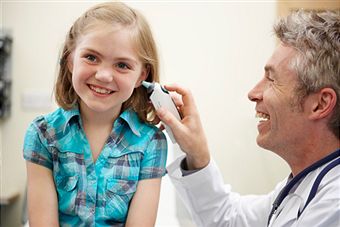Fevers
Fevers are your body’s way of letting you know something is off – your internal temperature is rising because your body is attempting to fight off an invading virus or infection.

There are many causes for the common fever, most of which are mild or only slightly worrysome. Some causes, however, can be an indication of something more serious and should be treated by a doctor immediately.
A fever is ultimately a symptom of a larger problem, some of which go away on their own and some of which must be resolved through medication and medical intervention.
Increase in Body Temperature
A fever is the technical term for an elevated body temperature, which may be measured in a variety of ways. Normal resting body temperature is around 98.6 degrees Fahrenheit, but may fluctuate up to a degree either way. To be technically declared a “fever”, the body must reach a temperature of 100.4 degrees Fahrenheit or higher.
Common Fever? Get Remedies Fast!
Temperatures of over 104 degrees Fahrenheit are potentially serious and even deadly, so medical attention should be sought immediately. The elderly and children are particularly vulnerable to the effects a fever can have, so seek medical attention immediately if someone in this category attains a fever of more than 104 degrees Fahrenheit.
Alternative Names
There are no alternative names for fever as it is not a disease in and of itself. Often referred to as a “common fever,” fever is generally associated with hot skin, uncontrollable body temperature, and other diseases or infections.
Symptoms
The common fever can have many outward symptoms and is relatively easy to spot and diagnose. As the fever itself is actually a symptom, other symptoms accompany fever with any virus:
Sweating – Profuse sweating and feelings of relentless heat are the hallmark symptoms of fever.
Shivering – Caused by the chills that sometimes come with fever, shivering usually comes in bouts and can be stopped through the application of clothes or blankets.
Headache – Caused by the fluctuating hormone levels via your fighting immune system
Loss of Appetite – Common with an cold or virus, many people do not feel hungry until their body temperature has stabilized
Dehydration – One of the more dangerous side effects of fever, dehydration is a direct cause/effect and should be monitored carefully
Hallucinations – Common in high fevers, many patient become delirious as their bodies attempt to regulate themselves
Convulsions – Only found in the most severe of all cases, the body may go into a state of shock if the fever and subsequent virus have weakened it to this degree
Causes
There are many different reasons a person may contract a fever, all of which have to do with exposure to an outside influence. These causes include:
Viruses
These are among the most common causes of fever in adults, and contain the dreaded influenza virus. Viruses also cause nausea, vomiting, and sore throat, and can be very contagious.
If you suspect you have a virus, choose to quarantine yourself for the first 3 days of illness to avoid spreading it to other people. Viruses cannot be treated by antibiotics or other means and usually must be allowed to exit the body naturally. Viruses usually cause a fever only at onset, and can themselves last anywhere from 2 days to 2 weeks.
Bacteria
Bacteria can affect almost any part of the body, and a fever is the body’s natural defense mechanism in this case. Bacterial infections can and should be treated with antibiotics to minimize spread.
Some of the more common types of bacterial infections include central nervous system, which affects the brain and spinal cord and can be life threatening, and respiratory system, which include pneumonia and bronchitis.
Other types include genitourinary system, which affects urination, and gastrointestinal, which causes stomach discomfort and pain. One of the more common and severe causes of fever can be bacterial infection of the skin. Difficult to treat, this type of infection can spread quickly and is hard to track down within the body.
Fungus
Much like a bacterial infection, fungi can create an inhospitable environment within the body for blood cells. This causes a fever as white blood cells attempt to fight off the fungus.
Traveler’s Fever
This is a blanket classification for all types of fever that can be caused by diseases and bacteria contracted while traveling. These include hepatitis A, yellow fever, and measles, and travelers should take caution to get vaccinated before traveling to affected areas. Many of these viruses and infections are entirely preventable.
Risk Factors
There are no hard and fast rules for who is at the greatest risk for fever. Certain people, like those with underdeveloped immune systems, seem to be more susceptible than others to viruses and bacteria, particularly while traveling or in a new environment. People who work with children or animals also more prone to contracting disease, which ultimately may cause a fever.
Fevers can and do affect people of both genders, and of any age. The elderly are particularly vulnerable and likely to obtain fevers and should be monitored with care if the contract one. Ethnicity does not seem to play a part in fever contraction.
Prevention Tips
There is no sure-fire way to ensure you will not contract a virus or get a fever. It’s never possible to completely isolate yourself from disease, but there are a few simple steps that can be taken to minimize the risk of contracting a disease or fever-causing bacteria.
Wash your hands
Often and thoroughly! Each time you eat, use the restroom, or touch a public surface you should wash your hands or use hand sanitizer to kill the germs you’ve picked up. These germs cause and spread viruses that may lead to fever.
Avoid contact with sick people
The spread of disease is not limited to those who are already ill, but coming in close contact with sick people raises the risk of contracting their virus.
Clean wounds thoroughly
As many of the worst fevers are caused by infection, cleaning an open wound thoroughly and promptly prevents the spread of bacteria. Bacteria found in even the smallest cuts and scrapes can cause an infection that could bring with it a fever.
Testing & Diagnosing
There are numerous options for taking the body’s temperature, some more effective than others. The standard “hand on the forehead” measurement, while somewhat comforting, is hardly accurate at measuring body temperature.
The following are a few of the ways doctors and nurses use thermometers to take temperature measures:
- Axillary – Under the armpit
- Eardrum – Via the ear canal
- Oral – Through the mouth, under the tongue
- Rectal – Using a standard straight thermometer
- Electronic – Can be used orally or rectally
Treatment Options
The treatment options for fever, while they may temporarily reduce redness, swelling, or feelings of heat, do not actually treat the fever. Rather, they treat the disease that’s causing the fever itself. There are many over the counter and home remedy solutions available for treating and “curing” a fever, though most only help ease discomfort while the fever runs its course through the body.

Herbal and At Home Remedies
Drink Water
You have a fever because your body is working hard to cool you off and fight off disease.
This means you may be losing a lot of water through sweat and perspiration, so naturally, replacing this lost water can help bring your internal temperature down.
Drink Juice
Some say the vitamins and antioxidants found in fruit and vegetable juices help replace the fluid lost through fever as well as shore up your immune system against persistent diseases.
Drink Tea
Certain teas, including those made from Linden, Willow Bark, and Black Elder have long been touted to have fever reducing properties, particularly when served cold.
Sponge Yourself Down
Rather than taking a bath, use a washcloth or sponge to add moisture to your skin. The evaporation of the water will provide a cooling sensation and encourage your body back to regular temperature levels.
Use a Compress
Cold, wet compresses offer similar relief to sponge baths as they encourage the body to reach homeostasis with the cooler compress that has been applied. When the compresses become hot, remove them and start over with fresh, cool compresses.
Pharmaceutical Remedies
There are several over-the-counter medication options when it comes to relieving a fever. The good news is, many of these pills help relieve the additional symptoms of your virus as well, such as headache, chills, and congestion. Use them sparingly or under a pharmacist’s or doctor’s care, particularly in the case of children.
Acetaminophen
Commonly found in Tylenol, Acetaminophen is designed to regulate the body’s internal temperature. This medicine should be used with particular care when given to children.
Ibuprofen
Found in Advil or Motrin, Ibuprofen is known for its ability to decrease pain sensitivity. Take 2 at a time for maximum relief, but never on an empty stomach.
Aspirin
The classic solution, aspirin is often given in cases of fever. Particularly harsh on the stomach lining, aspirin should never be given to children or taken in large doses as it can cause ulcers or hemorrhaging.
Surgical Remedies
There are no surgical remedies specifically for fever as it is not an isolated bodily injury. The only surgery related to fever relief is that which removes an infection or infected tissue. The infected tissue could be causing fever throughout the body and once it is removed, fever may be lessened.
Things NOT to do for your fever at home
Take a hot or cold bath – While the thought of submerging yourself in a cool tub can seem tempting, shocking the body so quickly can cause adverse reactions, like shivers or heat stroke, both of which are much worse than the offending fever.
Starve Yourself – The old adage of “Feed a cold, starve a fever” doesn’t hold much water. If you have a fever and find yourself hungry, eat. This is your body’s way of asking you to do something specific to make it better. If you’re not hungry, don’t feel as if you need to eat until you are.
Smother Yourself in Blankets – Oftentimes a severe fever is accompanied by chills, both of which can make you want to cover up then quickly cool off. Resist the urge to wrap yourself in blankets or sit directly in front of a fan as your body has a hard time adjusting to such sudden changes in external temperature.

5 Comments
i am suffering from fever frm last five days…my platlets goes down to 93000 docter advised me to not to take any medicine because its viral…so what can i do to get rid of??
Hey frnd if ur platelet count is gng down den u must immediately go to doctor because the normal count is 2,00,000. If there is severe drop in platelet count it could be dengue which can be serious..takecare..get well soon
According to hematologists and rheumatologists, normal platelet count is 140,000 to 400,000. They rarely get higher than that. I should know. I fall below the normal line and as long as they don’t drop below 29,000 then it’s nothing to worry about. This has been said by many health professionals.
I does t no exactly what is it . When I woke up in the morning my body heat my palm and legs are heat and tongue is sour it is go from last past year and I have consult to doctors what to do pls help me.
Full dry cough i went all doctor but not cleared what to do